Abstract
Beachrock is a type of coastal carbonate sedimentary rock developed in the sandy beach intertidal zone, widely distributed along the beach front, and the loss of beach sediment is the main cause of beachrock exposure. Based on the analysis of measured data of different exposure forms of beachrocks in profiles, this paper analyzes the main features and influences of non-dynamic factors, such as the exposure position and morphology, of beachrocks on the dynamic geomorphic processes of beaches. Studies have shown that (1) changes between beach energy dissipation bodies are significant features of coastal geomorphic processes under the influence of beachrocks. The first spatial mode of EOF analysis shows that the erosion position of beach-rock-exposed profiles is mainly concentrated in the protected and real sections of beachrock, and the first temporal mode indicates that the exposure of beachrock results in a lagged response of its profile to dynamic environmental changes. (2) The differences in the exposure forms of beachrocks determine the sand-holding space of the beach, and the differences in the lateral exposure positions of beachrocks determine the main areas where erosion occurs on the profile. Meanwhile, the geomorphic processes of their profiles show different degrees of feedback, and such geomorphic phenomena can serve as reference indicators for the stage-wise evolution process influenced by beachrocks.
1. Introduction
Beachrocks are hard coastal sedimentary formations consisting of various beach sediments, lithified through the precipitation of carbonate cements [1,2], widely distributed in the coastal foredune zone. Early newly cemented beachrock is mostly buried under the beach, and it emerges only after the erosion of surface sediments is almost complete, mostly appearing as a thin layer inclined 5–15° toward the sea [3]. Since the diagenetic process mostly occurs in the coastal intertidal zone [4], the cement products and sedimentary facies inside the rock record the characteristics of sea-level changes over multiple periods and the relative positions of ancient shorelines. This also enables beachrock to be a reference indicator for studying relative sea-level positions [5,6] and ancient bay evolution trends [7]. Once beachrock is formed, the accumulation of the shore determines whether it is exposed or buried [8,9,10,11]. The cementation of beachrock is a historical phenomenon on a global scale [2]. As the coastal erosion process accelerates, the exposure of beachrock is gradually becoming more common. The long-term exposure of beachrock also indicates that the corresponding shoreline may be subject to erosion. With further loss of sediment on the beach, completely exposed beachrock will further alter the characteristics of the entire beach.
The existence of hard constraints essentially determines the basic framework of beach formation and changes the accommodation space of littoral sediment and the volume change of the beach through response to the dynamic environment, thereby affecting its geomorphic processes. This type of influence, controlled by constraints, is often referred to as geological control (or geological inheritance) [12,13,14,15,16]. In nature, the hard constraints within coastal systems can take many different forms, and there is still a lack of specialized terminology in existing studies to describe beaches affected by such hard constraints. Most of them generally classify beaches affected by specific morphological features of hard constraints, such as rock platforms, rock ramps, or coral reefs, as constrained beaches. The presence of hard constraints may have produced boundary effects on the beach profile and further influenced the cross-shore and longshore sediment transport along the coast [17]. The feedback effect of exposed beachrock in the foredune zone on shaping the beach morphology also exhibited similar characteristics. After the exposure of buried beachrock in the intertidal zone, the sand accumulation on the high beach behind it developed slowly under its influence.
In the beach state classification system based on dimensionless fall velocity, Ω, and dynamic parameters, RTR [18,19], it seems difficult to identify the geomorphic forms of beaches affected by geological constraints (such as beaches developed in the intertidal zone with exposed rocks or subtidal reefs). Non-dynamic factors play a decisive and inherited role in shaping the morphology of beaches, to some extent [20]. Field observation data and related studies on beaches affected by geological constraint control showed that beaches with exposed rock formations are mostly in a state of limited sediment supply. In areas with active nearshore dynamics, large, exposed rock formations often occupy the area. On one hand, the development of rock formations can effectively reduce wave energy, stabilize the beach profile, and slow down further shoreline erosion [21,22]. On the other hand, the beach morphology at the interface between soft and hard substrates may weaken the cross-shore exchange of beach sediment, exhibiting corresponding erosion characteristics, such as the development of steep erosional ramps on the seaward edge of rock formations [23] and the development of ridge-and-runnel structures at the edge of rock formations in the intertidal zone [9]. Munoz-Perez’s observation results on the beaches of Cadiz in Spain indicated that both the siltation rate of uncontrolled beaches and the mobility of beach sediments were greater than those of beaches shielded by reef platforms [24]. Gallop’s profile-monitoring results of Yechep Beach on the southwest side of Australia, before and after a storm, indicated that although the reef shelter effectively reduced erosion during the storm, the amount of sediment recovery within a month after the storm was much less than that of an unsheltered beach profile. The reef shelter affected the erosion of the beach and whether it inhibited the subsequent sediment recovery to some extent [25].
In summary, we can conclude three main features of hard constraints on the beaches: (1) constraining the basic morphology of beach profiles, (2) weakening the response of the beach to the dynamic environment, and (3) intervening in the sediment budget of the beach. Currently, the focus of research mostly takes beachrocks, such as limestone or sedimentary rocks, as the main subject, with more emphasis on the lithification mechanism of beachrock [25,26] or related lithification environment studies, while relatively less attention has been given to the dynamic geomorphic processes and related research of beachrocks and their shore segments. The differences in the exposure location and morphology of beachrocks also add complexity to this type of problem. Based on this, this paper combines field geomorphological investigation and observation of the profiles of beachrock development shorelines, aiming to explore the main characteristics and effects of non-dynamic factors, such as the exposure position and morphology, of beachrocks on the dynamic geomorphic processes of beaches. The main contents of this study are as follows: (A) analysis of the morphological characteristics and evolutionary features between the exposed beachrock profiles based on multi-period measured profile data, and (B) discussion of the stage-wise evolutionary characteristics of beachrocks with different exposure forms.
2. Study Area
2.1. Geography
The southern coast of Hainan Island is composed of a series of bays interspersed with capes (Figure 1B). After the sea level dropped and stabilized during the late Pleistocene, long-term wave action re-transported nearshore sediment to the beach. Gradually, coastal dunes have developed along the coastline, where the original ancient coastal erosion and damage areas gradually accumulated to form today’s coastal dunes [27]. The beach slope ranges from 0.1 to 0.16. Enrichment of ancient shore facies sediments and suitable diagenetic environments triggered the initial cementation of early beachrocks in this area. Hongtang Bay is a bay open to the south at the mid-bay mouth of the southern part of Qiongnan Sea, stretching from Tianya Haijiao in the east to Nanshan Jiao in the west, and the middle Talin divides it into two relatively independent coastal units (Figure 1C).
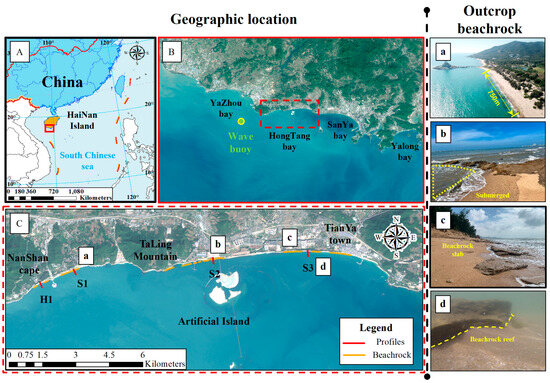
Figure 1.
(A–C) Location of Hongtang Bay. H1, S1, S2, and S3 are locations of the profile survey. (a–d) Positions of exposed beachrock in Hongtang Bay (photos of beachrock were taken in June 2021).
Currently, most of the known beachrocks along the coast of Hongtang Bay are in a shallow exposure state, and most of the beach sand layers still preserve relatively intact rock bodies underneath (Figure 1a–d). Although there is no direct evidence to characterize the strength of the cementation process in recent years, some relatively new shells and inactive coral debris embedded in the rock layers indicate that it is still in an active state.
2.2. Hydrodynamic Characteristics
The dynamic environment of Hongtang Bay is generally characterized by weak tides and strong waves, with the advancing tide waves of the South China Sea controlling the flow direction and tidal range changes in this area. The tidal currents in this area are mainly characterized by bidirectional flow, with flood tides flowing to the northwest and ebb tides flowing to the southeast. The average flow speed within a tidal cycle is about 0.2~0.5 m/s, showing irregular daily tides, with an annual average tidal range of 0.79 m and a maximum tidal range of 1.89 m. The rise in tidal level affects the dissipation of incoming waves on the exposed beachrocks in the beach foreland. During low tide, the exposed rock formations can be directly impacted by the waves, while during high tide, they are quickly submerged and become underwater reefs. According to the wave buoy data from outside Hongtang Bay, wind-driven waves dominate in this area, with prevailing waves predominantly concentrated in the ESE~SSE direction, and cumulative frequencies of wave heights below 1.5 m reaching 24%. Strong wave events are oriented toward the southwest (SW), mostly generated by short-term, strong prevailing westerly winds or tropical cyclones moving northward from the South China Sea. Wave heights are concentrated in the range of 1.5~2 m, with frequencies lower than 8% (Figure 2). The wave period is concentrated in the range of 8~12 s and, subsequently, in the summer and autumn seasons, the monsoon predominance gradually shifts to being dominated primarily by wind waves or mixed waves.
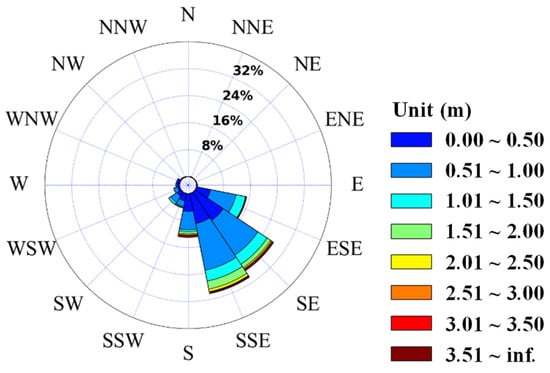
Figure 2.
The wave rise chart of the Hongtang Bay wave monitoring station (data were collected from 2016 to 2018).
2.3. Recent Morphodynamics of HongTang Bay
Since 1960, the local shoreline of Hongtang Bay has not shown a significant trend of erosion or accretion, remaining in a long-term stable state [28]. In recent years, coastal engineering construction has been the main factor causing changes in the shoreline of Hongtang Bay. During 2016–2017, the construction of an artificial island in the middle of Hongtang Bay may have altered the original sediment transport pattern of this section of coastline. After the construction of the artificial island, the surrounding shoreline was influenced, resulting in net alongshore sediment transport in areas sheltered by the artificial island. During this period, the sea area where Hongtang Bay is located also suffered from the impact of multiple storm events, resulting in significant local fluctuations in beach erosion and accretion. The major events impacting the beaches of Hongtang Bay were Typhoon “Doksuri” in September 2017 (No. 201719, typhoon number from China Meteorological Administration) and Tropical Storm “Etau” in November 2020 (No. 202022). Short-term, high-energy processes may have locally altered the erosion and accretion patterns of the local shoreline in Hongtang Bay. In these erosive environments, the loss of sediment from the beach surface has led to the gradual exposure of beachrocks that were originally buried beneath the beach (Figure 3).
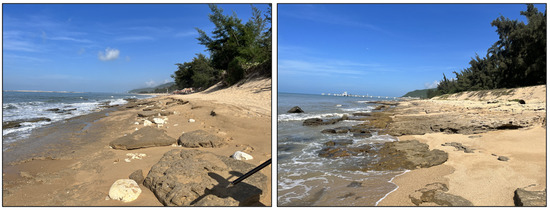
Figure 3.
Following the erosion of sediment, the exposed beachrock displays its morphology on the beach surface (photos of beachrock were taken in June 2021).
3. Materials and Methods
3.1. Field Survey
During the period from September 2017 (two days after the passage of the typhoon) to November 2021, four profiles were established at different shore sections in Hongtang Bay, and eight profile-tracking measurements were subsequently conducted (Figure 1C). The beach surface measuring instrument mainly used RTK-GPS, with the measurement range being from the top of the coastal dunes to near the low-tide waterline. The underwater topography was measured using the Wuxi Haiying HY1680 depth sounder. All elevation data were uniformly corrected to the local theoretical reference surface (0.9 m below mean sea level) after compilation. The position and geometric characteristics of exposed beachrocks at different shore sections (such as the rock contact point and slope inflection point) were quantified through fragmentary measurements. Due to the significant impact of beach erosion and sedimentation dynamics on the upper boundary of shallow-exposed beachrocks in different periods, there may be slight variations in their exposure status. However, based on multiple on-site geomorphological survey results, the intermittently exposed beachrocks did not experience fracturing damage during the monitoring period, and their relative positions on the profiles essentially remained unchanged.
3.2. Profile Analysis
3.2.1. The Parameterization of Profile Features
Considering the differences in the exposure positions and coverage ranges of beachrocks at different shore sections in Hongtang Bay, and to standardize the quantification of erosional features of beach profiles in different periods, this study divided beach profiles into three zones based on tidal characteristics: the supratidal zone (Zone I: above mean high-water spring (MHWS)), the intertidal zone (Zone II: between MLW and MHWS), and the subtidal zone (Zone III: 0 m contour to MLW; Figure 4). The corresponding beach single-width volume can be calculated by integrating the corresponding nodes.
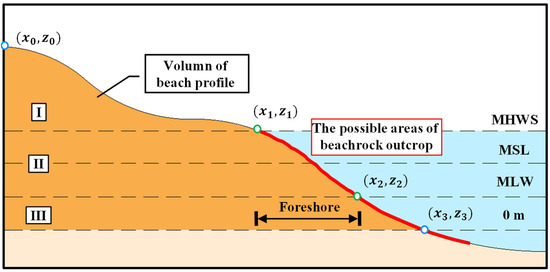
Figure 4.
Schematic diagram of beach profile elements; I (the supratidal zone), II (the subtidal zone), III (the intertidal zone), MHWS (mean high-water spring), MSL (mean sea level), and MLW (mean low water).
3.2.2. EOF (Empirical Orthogonal Function)
The empirical orthogonal function (EOF) analysis method is widely used in the study of beach profile evolution. The basic idea is to transform the original data through a matrix transformation [24,29,30,31]:
where represents the resampled and smoothed spatiotemporal matrix of the beach profile, represents the temporal modes of the empirical orthogonal functions, and represents the spatial modes of the empirical orthogonal functions. The subscript n is the mode number, with n values of 1, 2, and 3 corresponding to the first, second, and third modes, respectively. Calculating the contribution rate of variance for the corresponding modes in descending order of matrix eigenvalues allows the determination of the primary characteristics of the original data. After matrix flattening of the original data, corresponding spatial and temporal modes can be obtained. The intersection of spatial modes with the X-axis indicates the erosional equilibrium state at that point on the profile. If there are significant wave nodes and wave crests in the spatial modes, it indicates that sediment lateral exchange will occur between these nodes. The changes in temporal modes also indicate erosional features on the profile at different time scales, with intersections with the X-axis suggesting that sediment budgets may reach a nearly balanced state around that time point.
4. Results
4.1. Morphological Characteristics of Exposed Beachrocks
Due to the varied erosion characteristics among different shore sections in Hongtang Bay (Figure 1), the exposure of beachrocks was correspondingly limited in each shore section. The development of surface cracks in rock bodies indicated that beachrocks, once exposed to the beach surface, underwent direct mechanical abrasion, gradually leading to fragmentation. In this situation, the morphological characteristics of exposed beachrocks also varied. Based on the results of on-site geomorphological surveys, three different types of beachrocks could be identified in Hongtang Bay.
Ramp beachrock in the intertidal zone: This type of exposed beachrock was mainly concentrated within the 0–2 m contour range of the beach front, mostly in a state of shallow exposure. The slope of the exposed rock bodies mostly aligned with the slope of the adjacent beach, and generally sloped from the land to the sea at an angle of 5–10° (Figure 5a). Under the influence of tidal fluctuations, beachrocks in the intertidal zone often exhibited a state of submergence during high tides and exposure during low tides. During high tides, waves can surge over the rocks and directly impact the beach behind them, while the receding water further washes away sediment trapped in the surface of the rock. At the rock’s contact point, multiple parallel band-shaped flow marks could be observed. The intertidal exposure of beachrocks effectively altered the sequence of wave action on the beach. The exposed rock bodies replaced the loose sediment in the beach front and gradually became the primary dissipative element in their shore section. Wave dissipation through turbulent flow on the rock’s surface was the main energy dissipation mechanism for this type of exposed beachrock, with most incident wave energy dissipated at the solidified beach front. The beach behind, sheltered by the exposed rocks, could remain in a relatively stable state for an extended period.
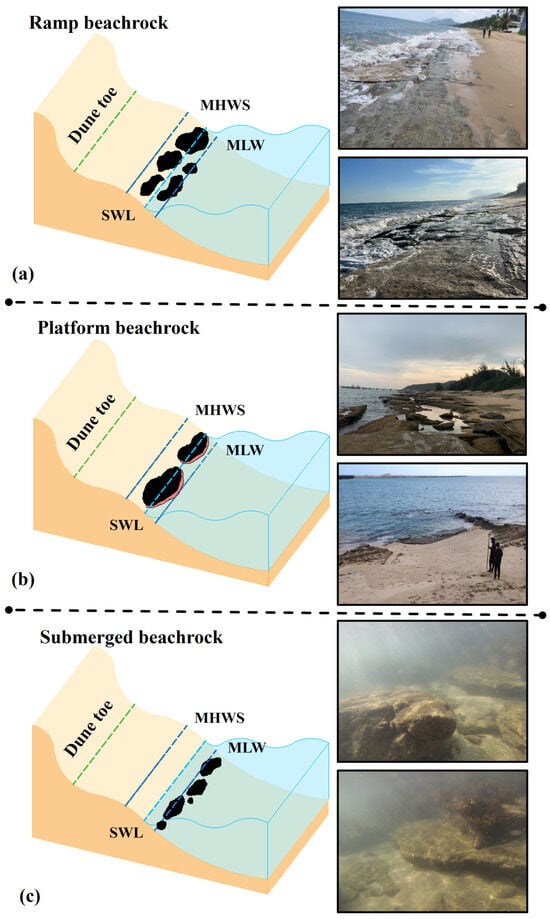
Figure 5.
Morphological characteristics of beachrocks with different exposure forms; (a) Ramp beachrock; (b) Platform beachrock; (c) Submerged beachrock (photos of beachrock were taken in June 2021).
Platform beachrock in the intertidal zone: This type of exposed beachrock was surrounded by mostly eroded sediment, and within the intertidal zone of the beach, it presented a relatively complete body of beachrock, mostly in the form of a rock platform exposed in the beach front. The exposed rock surface formed a certain angle with the direction of beach accumulation. The wedge-shaped notch pointing toward the landward edge of the beachrock was gradually eroded and dulled by wave action after exposure. Meanwhile, the edge of the rock body near the seaward side was often eroded by waves, forming an erosional scarp (Figure 5b). Due to the limited vertical protection range of this type of exposed beachrock within the intertidal zone, the incident waves could exhibit different wave energy dissipation modes during the rising and falling tide periods. During high tides, waves often broke and dissipated within the limited water depth of the exposed beachrock surface. The intense vertical mixing caused by this process may further scour the sediment at the contact point of the beachrock, leading to a strong upper modification of the beach under its protection, gradually smoothing the slope. During low tides, the exposed rock bodies could directly become the target of wave impact, while the beach behind was not directly affected by the waves during this period.
Submerged beachrock in the subtidal zone: This beachrock remained submerged in seawater throughout the year and was only exposed during extreme low tides. The rock bodies mostly served as substrates for the growth of nearshore aquatic vegetation (Figure 5c). This type of exposed beachrock may be a remnant of sea-level rise, causing a change in the original relative position of beachrocks that used to be exposed in the intertidal zone, accompanied by changes in the dynamic environment where the exposed beachrocks were located. Due to long-term exposure in the shallow nearshore zone, the submerged beachrocks were eroded, resulting in fragmentation. The sharp edges and corners at the fracture sites of the rock bodies were gradually eroded and dulled. Cracks developed from the surface to the inside, breaking into small blocks scattered around the large rock bodies. The width of the exposed beachrocks was mostly between 5 and 10 m, generally remaining in a fully exposed state. Although sedimentation and erosion on the beach surface can bury them at times, the thin layer of sand covering the rock surface can also be rapidly lost under the influence of waves.
4.2. Profile Evolution Characteristics under the Influence of Beachrocks
4.2.1. Morphological Evolution Characteristics of Beach Profiles
The sedimentation and erosion dynamics of beach profiles represent macroscopic expressions of self-adjustment to dynamic shaping at different time scales. However, the evolution patterns mentioned above may undergo changes when beachrocks are present within the beach profile. As shown in Figure 2, during the monitoring period, the sedimentation and erosion activities on the H1 profile were more active. Significant changes were mainly concentrated in the shallow region around the 0 m contour, and a beach shoulder developed near the 2 m contour in November 2020, while the beach shoulder disappeared in the two observations in 2021 (Figure 6). In comparison to the H1 profile, the sedimentation and erosion variations on the S1 profile were less pronounced during the monitoring period. The average beach slope was 0.12, and the overall lateral sedimentation and erosion fluctuation near the high-tide line did not exceed 5 m. The presence of ramp beachrock, a type of beachrock with a sloping intertidal exposure, essentially defined the erosion lower limit and maintained a relatively stable state for this profile.

Figure 6.
Evolution features of beach profiles in different sections during the monitoring period (gray-filled area indicates the region covered by exposed beachrocks).
The S2 profile was located in an erosion hotspot during the artificial shore construction process from 2016 to 2017. After the completion of the artificial shore at the end of 2017, erosion continued to occur at this profile due to its influence. As a result, sediment in the intertidal zone was significantly lost, exposing relatively intact platform-type beachrock bodies (platform beachrock). This erosion trend gradually eased after June 2019. During the monitoring period, the relative position of the exposed beachrock did not change, further constraining the morphological transformation of the beach profile in the unprotected segment. The profile morphology above the 1 m contour shifted from the original straight steep slope to a locally concave arc, forming an erosion scarp with a slope of 0.3 between the 2 m and 4 m contours. The slope between the 1 m and 2 m contours gradually flattened, changing from the original 0.14 to 0.09. The high beach section above the 4 m contour on the beach profile remained relatively stable, and the long-term exposure of beachrocks was a key factor contributing to the slow erosion and gradual stabilization of this beach segment.
The beachrocks (submerged beachrock) exposed near the 0 m contour on the S3 profile were submerged underwater throughout the year. Due to their low-exposure elevation, the sedimentation and erosion dynamics of the beach along the rock body were relatively active during the monitoring period, compared to the beach profile influenced by intertidal exposed beachrocks. The sedimentation and erosion amplitude range of the beach at the 2 m contour reached 10 m during this period. In November 2020, the profile was affected by the action of the typhoon environment (No. 202022). Some sediment in the elevation range of 2~3 m in the high-tide zone accumulated to the high beach at the 4 m contour during this process, while the overall erosion in the intertidal to high tide zones decreased by 1 m. The elevation of the beachrocks in the subtidal zone showed almost no significant changes. In the subsequent observations, the sediment on the high beach of this profile fell back to near the intertidal zone, and the beach profile returned to its original form. Overall, the sedimentation and erosion amplitude of the rock development position in this profile during the monitoring period was relatively small, compared to other parts.
4.2.2. Variation in Beach Single-Width Volume
The changes in the single-width volume of beach profiles can visually indicate the variations in beach sand quantity and erosion trends in different periods for the respective segments (Table 1). Overall, the H1 profile exhibited significant fluctuations in the single-width volume during the monitoring period, with an average sedimentation and erosion amplitude of 18.3 /m from June 2020 to June 2021. Although the cumulative decrease in the beach’s single-width volume during the monitoring period was 24.5 /m, it may be attributed to short-term sedimentation and erosion fluctuations. In comparison, the S1 profile was relatively stable during the monitoring period, with a slight overall accretion, and the maximum erosion amplitude did not exceed 5 /m. The S2 profile experienced a total decrease of 23.7 /m in the single-width volume during the monitoring period, with erosion concentrated in the intertidal zone lacking beachrock protection, while the area covered by intertidal beachrocks remained relatively stable in terms of single-width volume (Figure 7). Although there was a slight accumulation in this profile from June 2020 to June 2021, the accretion volume was much smaller than the erosion volume, indicating that the profile was in a state of sediment imbalance and slow erosion during the monitoring period. The S3 profile accumulated a decrease of 9.8 /m during the monitoring period, with significant fluctuations in the single-width volume in the beach intertidal and upper intertidal zones, while the area where beachrocks were exposed in the subtidal zone remained relatively stable, indicating that the exposed beachrocks in the subtidal zone may not have affected the sediment exchange between the intertidal and upper intertidal zones.

Table 1.
Total volume changes of each beach profile (unit: m3/m).
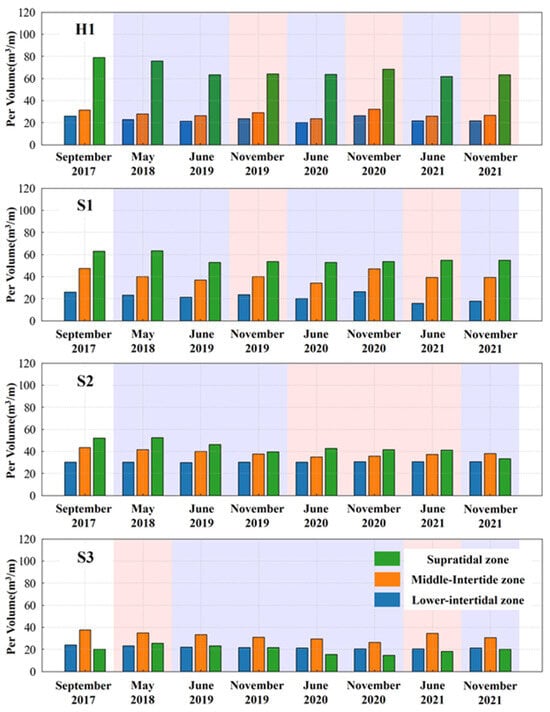
Figure 7.
Changes in the single-width volume of different zones in various beach profiles during the monitoring period (color-filled with features of accretion compared to the last observation, with red indicating accretion and blue indicating erosion).
4.2.3. Empirical Orthogonal Function (EOF) Analysis
The results of empirical orthogonal function (EOF) analysis on different profiles in Hongtang Bay indicated that the contribution rates of the first three modes exceeded 90%, representing the main trends in beach profile evolution (Table 2). The first spatial mode’s variation was a major characteristic of beach profile changes (Figure 8). In the H1 profile, the first spatial mode had two nodes at positions 13 m and 20 m, with extremes appearing near 30 m. This trend suggested significant lateral sediment exchange between the upper intertidal and intertidal zones. Combined with the evolution of profile morphology, it may represent the self-adjustment of the beach profile in response to dynamic environmental changes at different periods. The first spatial mode of the S1 profile also exhibited extremes in the upper intertidal zone, showing low-amplitude negative fluctuations in the intertidal zone where beachrock was exposed. The first spatial mode of the S2 profile had extremes near 15 m, gradually decreasing toward the sea, indicating an overall erosive state of the beach profile in the 8~40 m range. The function values remained at low amplitudes where beachrock was exposed. The first spatial mode of the S3 profile showed similar characteristics. The locations of these extremes suggested that the areas lost on profiles with exposed beachrock were mainly concentrated in segments lacking beachrock protection. The low function values of spatial modes at lower elevations of exposed beachrock suggested that the exposed beachrock limited the erosion base of the profile, potentially constraining and weakening sediment exchange between the upper intertidal and intertidal zones on the profile. The second and third spatial modes may indicate short-term trends in beach profile changes, likely corresponding to dynamic features at their respective time scales, but they did not show significant trends.

Table 2.
The proportion of variance explained by the first three characteristic functions in each beach profile.
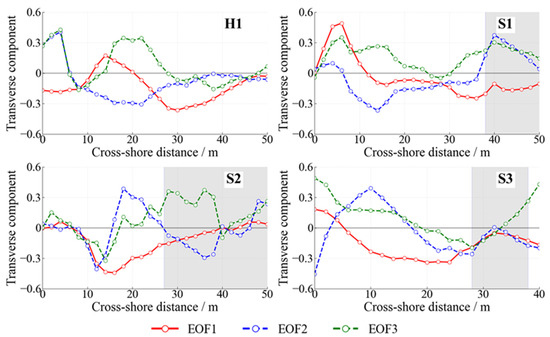
Figure 8.
Spatial modes of beach profiles in different sections during the monitoring period (gray-filled areas indicate regions covered by exposed beachrock).
From the perspective of the time modes, the erosion trends of each profile were not very apparent (Figure 9). Although there may be seasonal variations in erosion in the T4~T8 periods, further analysis may be needed to determine whether there were regressive features of seasonal erosion trends. In terms of trend changes, the first time-mode fluctuations of the H1 profile were more significant compared to the S1~S3 profiles. Additionally, during the T3~T6 period, it exhibited significant alternating seasonal erosion features. In contrast, the changes in the S1~S3 profiles were not as pronounced. This suggested that the profiles with exposed beachrock exhibited a lag in response to dynamic environmental conditions, allowing them to maintain a relatively stable state over the long term.
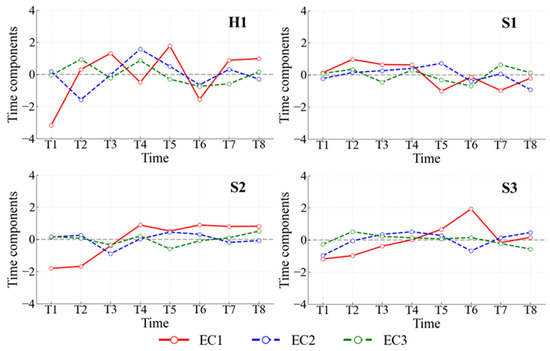
Figure 9.
Temporal modes of beach profiles in different sections during the monitoring period (gray-filled areas indicate regions covered by exposed beachrock). T1~T8 represent a total of 8 time nodes from September 2017 to June 2021.
5. Discussion
In summary, under the influence of beachrock, the dynamic geomorphic processes of the respective profiles were significantly controlled by the geological strata. The differences in the exposure location and morphology of beachrock also led to distinct features in the evolution processes of the profiles. Below, we will explore the following: (1) the impact of beachrock exposure on coastal geomorphic processes and (2) the role of beachrock exposure morphology and location.
5.1. The Effect of Beachrock Outcrop in Beach Morphology
The changes in the dissipative bodies between beaches are a significant feature of coastal geomorphic processes under the influence of beachrock. When buried beachrock emerges on the beach surface, the dissipative body of the corresponding profile transforms from loose littoral deposits to exposed beachrock. Exposed beachrock in the front beach effectively serves as the first line of defense against wave erosion, and the development of rock bodies helps define the basic morphology of the beach profile. The reduced sediment transport capacity results in overall smaller fluctuations in erosion and deposition in the beachrock-affected profile, allowing it to maintain a relatively stable state over the long term.
The imbalance in the sediment budget induced by changes in the dissipative bodies of the beach is likely a potential threat when beachrock is exposed. Firstly, the development of beachrock itself does not contribute sediment to the beach; instead, it may occupy some sediment storage space on the beach, reducing its self-adjusting resilience. This makes erosion occur primarily in the beachrock-unprotected section when responding to extreme weather conditions. Although the cementation development of beachrock may reduce some littoral sediment [8], this behavior lacks observational data for support. Secondly, exposed beachrock effectively weakens the dynamics acting on the beach surface near the shore. This type of hard structure distributed near the surface reduces the incident wave energy and weakens the sand-carrying capacity of the swash zone, resulting in the beach upper foreshore being in a low-energy dynamic environment for an extended period. Sediment return may also be relatively restricted, and the beach, which is in a long-term sediment transport imbalance, may become a potential erosion hotspot [16], even driving gradual beach degradation.
5.2. The Role of Outcrop Beachrock’s Shape and Position
The exposure of beachrock is a significant feature of its coastal section changing from unconstrained to constrained control. Due to the diversity and complexity of the diagenetic process, the differences in the morphology of exposed beachrock seem to affect the movement of beach sediments and play a framing role in its profile [32,33]. Morphologically, this framing constraint seems to affect the sediment storage space on the beach surface. The differences in the exposure positions of beachrocks are closely related to the erosional trends on the beach surface, determining the main regions where erosion can occur on the profile. Rutten categorizes the feedback effects of beachrock exposure on the coastline into 3 stages: ① slow-down stage of coastline retreat (Phase 0~2), ② acceleration stage of coastline retreat (Phase 3~5), and ③ dynamic equilibrium stage (Phase 6), and different morphological features can be observed in different stages [10]. Based on the results of this study, the profiles of ramp beachrock and submerged beachrock may have been in the stage of slowing down the coastline retreat, while the platform beachrock was in the transitional stage between Phase 1 and Phase 2 (Phase 2 to Phase 3). After the sediment at the beachrock shore gradually erodes almost completely, the backwash will quickly converge at the rock’s shore, causing erosion and forming gullies (Phase 3). The sediment balance of the beach is then further affected. These morphological features, to some extent, indicate the development trends of dynamic geomorphic processes on the beach influenced by beachrocks. Whether the evolution direction of these features is reversible and the potential influencing factors still need further investigation and support.
6. Conclusions
This study conducted on-site geomorphic surveys and multi-period profile monitoring of the exposed beachrock shores in Hongtang Bay, analyzing the distribution and morphological characteristics of the current exposed beachrocks. The research results indicate:
- (1)
- The profiles S1~S3, which had exposed beachrocks, demonstrated a higher level of stability in terms of profile morphology, sediment volume, EOF spatial modes, and temporal modes, compared to the H1 profile without exposed beachrocks. The reduction in sediment transport capacity due to the presence of exposed beachrocks resulted in overall smaller variations in erosion and deposition within the profile, leading to a weakened response to dynamic environmental changes.
- (2)
- Differences in the exposed forms of beachrocks determined the influence on the sediment accommodation space of the beach. Lateral variations in the exposure positions of beachrocks decided the main areas of erosion on the profile, and the geomorphic processes of the profiles under the influence of beachrocks showed different degrees of feedback. These geomorphic features can serve as reference indicators for the phased evolution of beach sections influenced by beachrocks.
Author Contributions
Conceptualization, J.X. and Y.W.; methodology, J.X.; software, J.X.; validation, J.X., Y.W. and P.L.; formal analysis, J.X.; investigation, J.X.; resources, J.X.; data curation, J.X.; writing—original draft preparation, J.X.; writing—review and editing, J.X.; visualization, Y.W.; supervision, Y.W.; project administration, Y.W.; funding acquisition, P.L. All authors have read and agreed to the published version of the manuscript.
Funding
The financial support is provided by China Huaneng Group Co., Ltd. (HNKJ23H18), Ministry of Water Resources of the People’s Republic of China (SKS2022089).
Institutional Review Board Statement
Not applicable.
Informed Consent Statement
Not applicable.
Data Availability Statement
The raw data supporting the conclusions of this article will be made available by the authors on request.
Conflicts of Interest
The authors declare no conflicts of interest. The funders had no role in the design of the study; in the collection, analyses, or interpretation of data; in the writing of the manuscript, or in the decision to publish the result.
References
- Mauz, B.; Vacchi, M.; Green, A.; Hoffmann, G.; Cooper, A. Beachrock: A Tool for Reconstructing Relative Sea Level in the Far-Field. Mar. Geol. 2015, 362, 1–16. [Google Scholar] [CrossRef]
- Vousdoukas, M.I.; Velegrakis, A.F.; Plomaritis, T.A. Beachrock Occurrence, Characteristics, Formation Mechanisms and Impacts. Earth-Sci. Rev. 2007, 85, 23–46. [Google Scholar] [CrossRef]
- Ginsburg, R.N. Beachrock in South Florida. J. Sediment. Res. 1953, 23, 85–92. [Google Scholar] [CrossRef]
- Kneale, D.; Viles, H.A. Beach Cement: Incipient CaCO3-Cemented Beachrock Development in the Upper Intertidal Zone, North Uist, Scotland. Sediment. Geol. 2000, 132, 165–170. [Google Scholar] [CrossRef]
- Falkenroth, M.; Schneider, B.; Hoffmann, G. Beachrock as Sea-Level Indicator–a Case Study at the Coastline of Oman (Indian Ocean). Quat. Sci. Rev. 2019, 206, 81–98. [Google Scholar] [CrossRef]
- Kelletat, D. Beachrock as Sea-Level Indicator? Remarks from a Geomorphological Point of View. J. Coast. Res. 2006, 22, 1558–1564. [Google Scholar] [CrossRef]
- Kelly, C.S.; Green, A.N.; Cooper, J.A.G.; Wiles, E. Beachrock Facies Variability and Sea Level Implications: A Preliminary Study. J. Coast. Res. 2014, 736–742. [Google Scholar] [CrossRef]
- Cooper, J.A.G. Beachrock Formation in Low Latitudes: Implications for Coastal Evolutionary Models. Mar. Geol. 1991, 98, 145–154. [Google Scholar] [CrossRef]
- Rey, D.; Rubio, B.; Bernabeu, A.M.; Vilas, F. Formation, Exposure, and Evolution of a High-Latitude Beachrock in the Intertidal Zone of the Corrubedo Complex (Ria de Arousa, Galicia, NW Spain). Sediment. Geol. 2004, 169, 93–105. [Google Scholar] [CrossRef]
- Rutten, G.L. Interactions between Beachrock Formations and Shoreline Evolution. Case Study: Togo. Master’s Thesis, Delft University of Technology, Delft, The Netherlands, 2011. [Google Scholar]
- Cooper, J.A.G.; Green, A.N.; Wiles, E.A. Beachrock Morphology and Genesis on a Paraglacial Beach. Sediment. Geol. 2017, 360, 47–53. [Google Scholar] [CrossRef]
- Gallop, S. Classification of Perched Beach Morphotypes and the Influence of Coastal Reefs on Sandy Beach Morphodynamics during Storms and Sea Breezes. Ph.D. Thesis, The University of Western Australia, Perth, Australia, 2013. [Google Scholar]
- Gallop, S.L.; Kennedy, D.M.; Loureiro, C.; Naylor, L.A.; Muñoz-Pérez, J.J.; Jackson, D.W.T.; Fellowes, T.E. Geologically Controlled Sandy Beaches: Their Geomorphology, Morphodynamics and Classification. Sci. Total Environ. 2020, 731, 139123. [Google Scholar] [CrossRef] [PubMed]
- Jackson, D.W.T.; Cooper, J.A.G. Geological Control on Beach Form: Accommodation Space and Contemporary Dynamics. J. Coast. Res. 2009, I, 69–72. [Google Scholar]
- McNinch, J.E. Geologic Control in the Nearshore: Shore-Oblique Sandbars and Shoreline Erosional Hotspots, Mid-Atlantic Bight, USA. Mar. Geol. 2004, 211, 121–141. [Google Scholar] [CrossRef]
- Short, A.D. Role of Geological Inheritance in Australian Beach Morphodynamics. Coast. Eng. 2010, 57, 92–97. [Google Scholar] [CrossRef]
- Loureiro, C.; Ferreira, Ó.; Cooper, J.A.G. Geologically Constrained Morphological Variability and Boundary Effects on Embayed Beaches. Mar. Geol. 2012, 329, 1–15. [Google Scholar] [CrossRef]
- Masselink, G.; Short, A.D. The Effect of Tide Range on Beach Morphodynamics and Morphology: A Conceptual Beach Model. J. Coast. Res. 1993, 9, 785–800. [Google Scholar]
- Wright, L.D.; Short, A.D. Morphodynamic Variability of Surf Zones and Beaches: A Synthesis. Mar. Geol. 1984, 56, 93–118. [Google Scholar] [CrossRef]
- Jackson, D.W.T.; Cooper, J.A.G.; Del Rio, L. Geological Control of Beach Morphodynamic State. Mar. Geol. 2005, 216, 297–314. [Google Scholar] [CrossRef]
- Calvet, F.; Cabrera, M.C.; Carracedo, J.C.; Mangas, J.; Pérez-Torrado, F.J.; Recio, C.; Travé, A. Beachrocks from the Island of La Palma (Canary Islands, Spain). Mar. Geol. 2003, 197, 75–93. [Google Scholar] [CrossRef]
- Dickinson, W.R. Holocene Sea-Level Record on Funafuti and Potential Impact of Global Warming on Central Pacific Atolls. Quat. Res. 1999, 51, 124–132. [Google Scholar] [CrossRef]
- Vousdoukas, M.I.; Velegrakis, A.F.; Karambas, T.V. Morphology and Sedimentology of a Microtidal Beach with Beachrocks: Vatera, Lesbos, NE Mediterranean. Cont. Shelf Res. 2009, 29, 1937–1947. [Google Scholar] [CrossRef]
- Muñoz-Perez, J.J.; Medina, R. Comparison of Long-, Medium-and Short-Term Variations of Beach Profiles with and without Submerged Geological Control. Coast. Eng. 2010, 57, 241–251. [Google Scholar] [CrossRef]
- Gischler, E.; Lomando, A.J. Holocene Cemented Beach Deposits in Belize. Sediment. Geol. 1997, 110, 277–297. [Google Scholar] [CrossRef]
- Zhang, X.-Y.; Li, Y.; Sun, F.-L.; Tan, F.; Shi, Q.; Yan, H.-Q.; Wang, G.; Yang, H.-Q. Insights into Microbially Mediated Cementation in Modern Beachrock in the Xisha Islands, South China Sea. Palaeogeogr. Palaeoclimatol. Palaeoecol. 2022, 592, 110904. [Google Scholar] [CrossRef]
- Qianwen, S.; Kangyou, H.; Dehao, X. On the sedimentary environment change since Holocene in the Sanya Bay, Hainan Island. Acta Sci. Nat. Univ. Sunyatseni 2019, 58, 13–21. [Google Scholar] [CrossRef]
- Wang, Y. Study on the Impact of Sanya New Airport Artificial Island on Hongtang Bay Beach; Chinese Society for Oceanography: Beijing, China, 2017; pp. 977–982. [Google Scholar]
- Medellín, G. Morphodynamics along a Micro-Tidal Sea Breeze Dominated Beach in the Vicinity of Coastal Structures. Mar. Geol. 2019, 417, 106013. [Google Scholar] [CrossRef]
- Habel, S.; Fletcher, C.H.; Barbee, M.; Anderson, T.R. The Influence of Seasonal Patterns on a Beach Nourishment Project in a Complex Reef Environment. Coast. Eng. 2016, 116, 67–76. [Google Scholar] [CrossRef]
- Lemke, L.; Miller, J.K. EOF Analysis of Shoreline and Beach Slope Variability at a Feeder Beach Constructed within a Groin Field at Long Branch, New Jersey. Coast. Eng. 2017, 121, 14–25. [Google Scholar] [CrossRef]
- Trenhaile, A.S. Modeling the Accumulation and Dynamics of Beaches on Shore Platforms. Mar. Geol. 2004, 206, 55–72. [Google Scholar] [CrossRef]
- Trenhaile, A.S. Modelling the Effect of Waves, Weathering and Beach Development on Shore Platform Development. Earth Surf. Process. Landf. J. Br. Geomorphol. Res. Group 2005, 30, 613–634. [Google Scholar] [CrossRef]
Disclaimer/Publisher’s Note: The statements, opinions and data contained in all publications are solely those of the individual author(s) and contributor(s) and not of MDPI and/or the editor(s). MDPI and/or the editor(s) disclaim responsibility for any injury to people or property resulting from any ideas, methods, instructions or products referred to in the content. |
© 2024 by the authors. Licensee MDPI, Basel, Switzerland. This article is an open access article distributed under the terms and conditions of the Creative Commons Attribution (CC BY) license (https://creativecommons.org/licenses/by/4.0/).